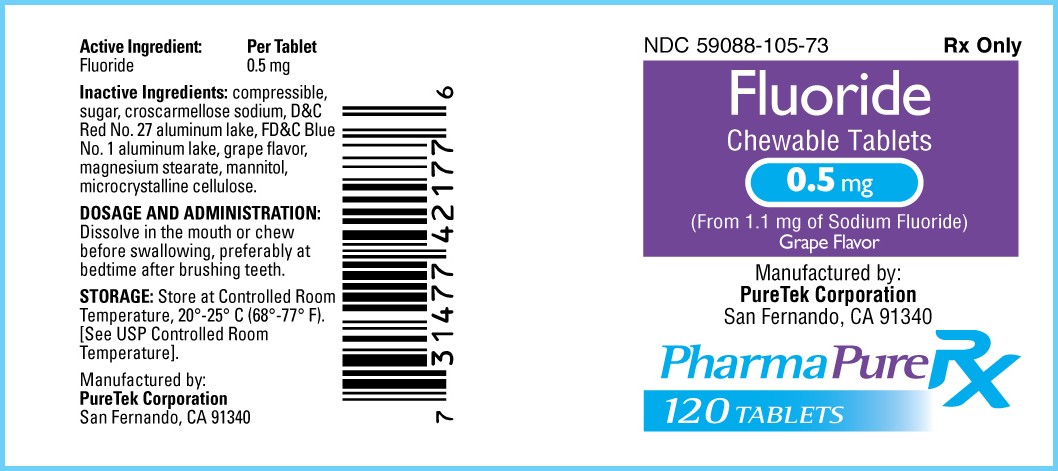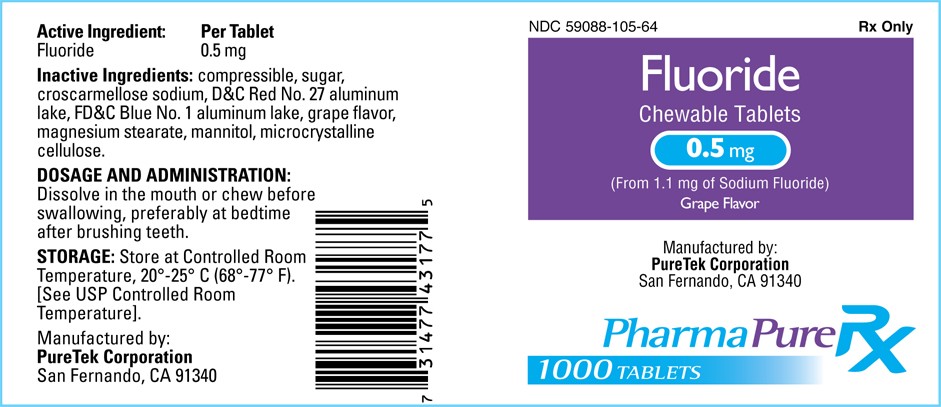Fluoride
Prescribing Information
FULL PRESCRIBING INFORMATION: CONTENTS*
- FLUORIDE DESCRIPTION
- CLINICAL PHARMACOLOGY
- FLUORIDE INDICATIONS AND USAGE
- FLUORIDE CONTRAINDICATIONS
- WARNINGS
- PRECAUTIONS
- FLUORIDE ADVERSE REACTIONS
- OVERDOSAGE
- FLUORIDE DOSAGE AND ADMINISTRATION
- HOW SUPPLIED
- STORAGE
- Inactive Ingredients
- 120 ct Base Label
- 120 ct Inside Label
- 120 ct Outside Label
- 1000 ct Base Label
- 1000 ct Inside Label
- 1000 ct Outside Label
FULL PRESCRIBING INFORMATION
FLUORIDE DESCRIPTION
Each Fluoride Chewable Tablet 0.5 mg is erythrosine (FD and C Red Dye No. 3) free. Each tablet 0.5 mg (half-strength) contains 0.5 mg F* from 1.1 mg sodium fluoride (NaF).
CLINICAL PHARMACOLOGY
Sodium fluoride acts systemically (before tooth eruption) and topically (post eruption) by increasing tooth resistance to acid dissolution, by promoting remineralization, and by inhibiting the cariogenic microbial process.
FLUORIDE INDICATIONS AND USAGE
For once daily self-applied systemic use as a dental caries preventive in pediatric patients. It has been established that ingestion of fluoridated drinking water (1 ppm F*) during the period of tooth development results in a significant decrease in the incidence of dental caries. Fluoride Chewable Tablets were developed to provide systemic fluoride for use as a supplement in pediatric patients from 6 months to 3 years of age and older living in areas where the drinking water fluoride content does not exceed 0.6 ppm F*.
FLUORIDE CONTRAINDICATIONS
Fluoride Chewable Tablets 0.5 mg * *WARNINGS
Prolonged daily ingestion of quantities greater than the recommended amount may result in various degrees of dental fluorosis in pediatric patients under age 6 years, especially in the water fluoridation exceeds 0.6 ppm. Read directions carefully before using.
PRECAUTIONS
GeneralCONTRAINDICATIONS, WARNINGS,OVERDOSAGE
Drug interactions
Do not eat or drink dairy products within one hour of fluoride administration. Incompatability of fluoride with dairy foods has been reported due to formation of calcium fluoride which is poorly absorbed.
Carcinogenesis, Mutagenesis, Impairment of Fertility
In a study conducted in rodents, no carcinogenesis was found in male and female mice and female rats treated with fluoride at dose levels ranging from 4.1 to 9.1 mg/kg of body weight. Equivocal evidence of carcinogenesis was reported for male rats treated with 2.5 mg and 4.1 mg of body weight. In a second study, no carcinogenesis was observed in rats, males or females treated with fluoride up to 11.3 mg/kg of body weight. This dose is at least 400 times greater than the recommended daily dose of Fluoride Chewable Tablets. Fluoride ion is not mutagenic in standard bacterial systems. It has been shown that fluoride ion has potential to induce chromosome aberrations in cultured human and rodent cells at doses much higher than those in which humans are exposed. In vivo data is conflicting. Some studies report chromosome damage in rodents while other studies using similar protocols report negative results. Potential adverse reproductive effects of fluoride exposure in humans has not been adequately evaluated. Adverse effects on reproduction were reported for rats, mice, fox, and cattle exposed to 100 ppm or greater concentrations of fluoride in their diet or drinking water. Other studies conducted in rats demonstrated that lower doses of fluoride (5 mg/kg of body weight) did not result in impaired fertility and reproductive capabilities.This dose is approximately 200 times greater than the recommended daily dose of Fluoride Chewable Tablets.
Pregnancy
Teratogenic Effects: Pregnancy Category B. It has been shown that fluoride crosses the placenta of rats, but only 0.01% of the amount administered is incorporated in fetal tissue. Animal studies (rats, mice, rabbits) have shown that fluoride is not a teratogen. Maternal exposure to 12.2 mg fluoride/kg of body weight (rats) or 13.1 mg/kg of body weight (rabbits) did not affect the litter size or fetal weight and did not increase the frequency of skeletal or visceral malformations. Epidemiological studies conducted in areas with high levels of naturally fluoridated water showed no increase in birth defects. Heavy exposure to fluoride during in utero development may result in skeletal fluorosis which becomes evident in childhood.
Nursing Mothers
It is not known if fluoride ion is excreted in human milk. However, many drugs are excreted in human milk and caution should be exercised when Fluoride Chewable Tablets 0.5 mg are administered to nursing women. Reduced milk production was reported in farm-raised fox when the animals were fed a diet containing a high concentration of fluoride (98 – 137 mg/kg of body weight). No adverse effects on parturition, lactation, or offspring were seen in rats administered fluoride up to 5 mg/kg of body weight. This dose is at least 200 times greater than the recommended daily dose of Fluoride Chewable Tablets.
Pediatric Use
The use of Fluoride Chewable Tablets 0.5 mg as a caries preventive in pediatric age groups 6 months to 16 years is supported by evidence from adequate and well-controlled studies on fluoride supplementation from birth through adolescence.
Geriatric Use
Fluoride Chewable Tablets 0.5 mg are not indicated for use in geriatric patients.
FLUORIDE ADVERSE REACTIONS
Allergic rash and other idiosyncrasies have rarely been reported.
Call your doctor for medical advice about side effects. You may report side effects to the FDA at 1-800-FDA-1088.
OVERDOSAGE
FLUORIDE DOSAGE AND ADMINISTRATION
HOW SUPPLIED
STORAGE
Store at Controlled Room Temperature, 20°-25°C (68°-77°F). [See USP Controlled Room Temperature].
Inactive Ingredients
120 ct Base Label

120 ct Inside Label

120 ct Outside Label

1000 ct Base Label

1000 ct Inside Label

1000 ct Outside Label

FluorideSodium Fluoride TABLET, CHEWABLE
| |||||||||||||||||||||||||||||||||||||||||||||||||||||||||||||||||||||||||||||||||||||